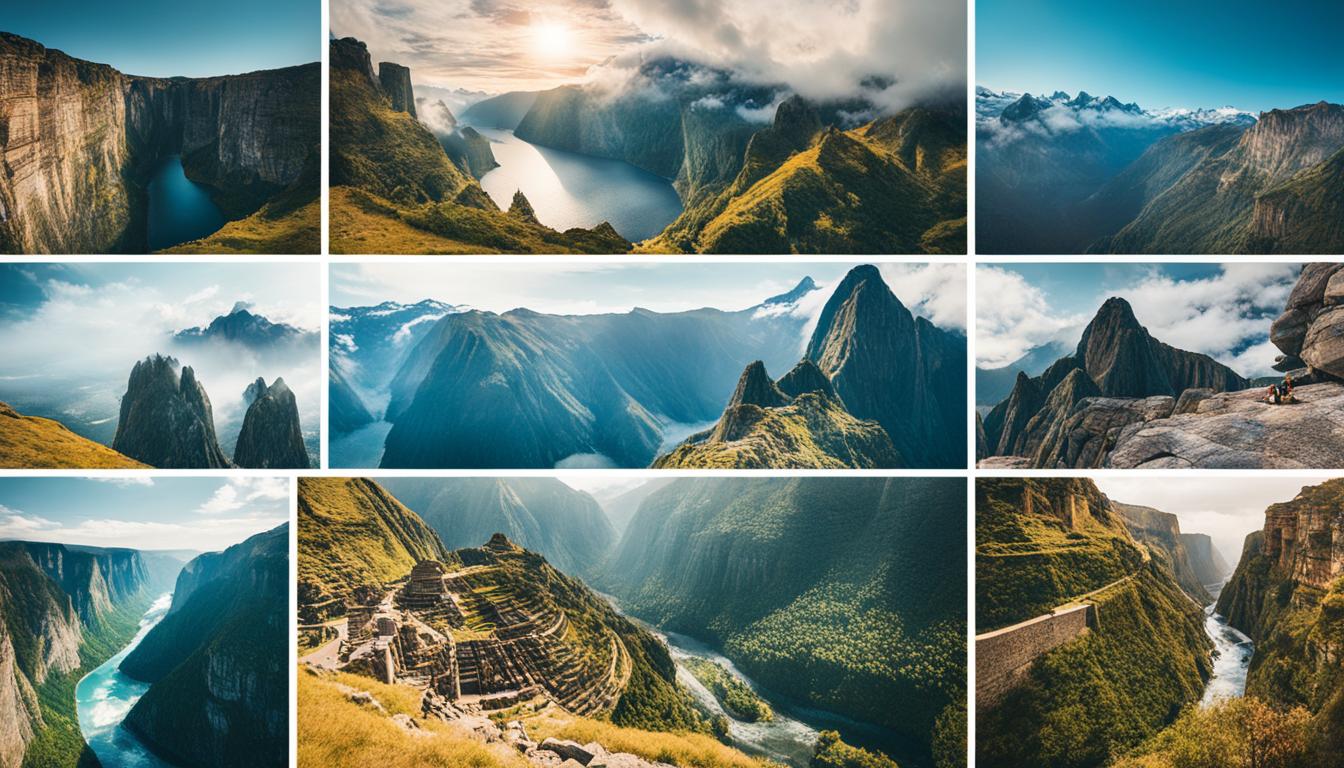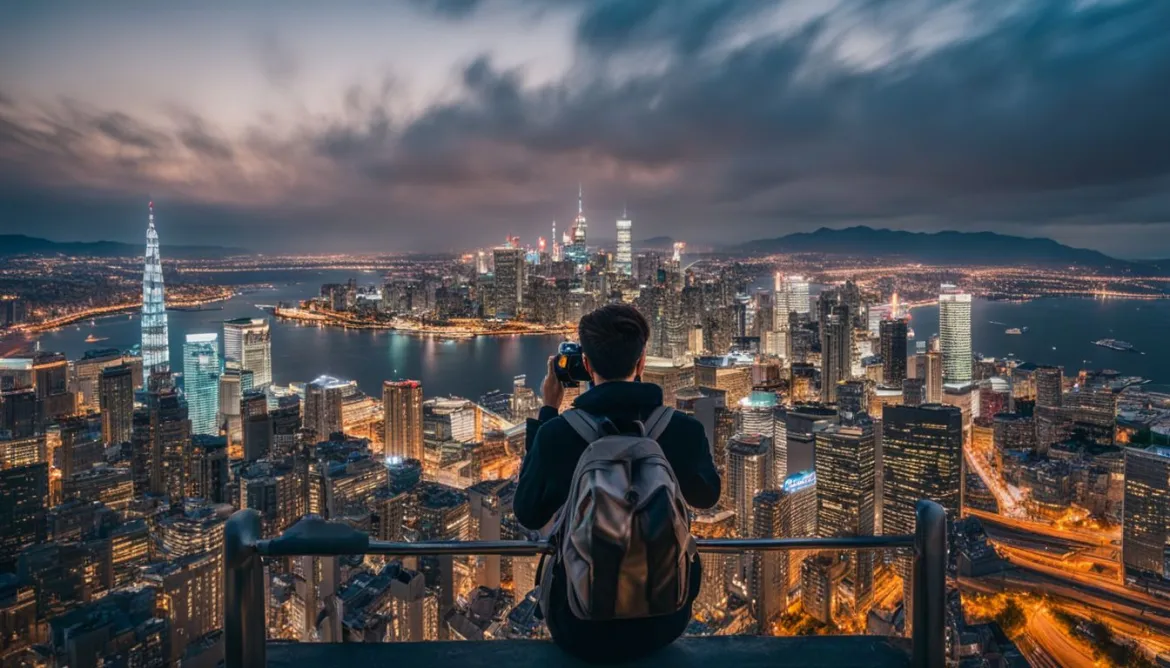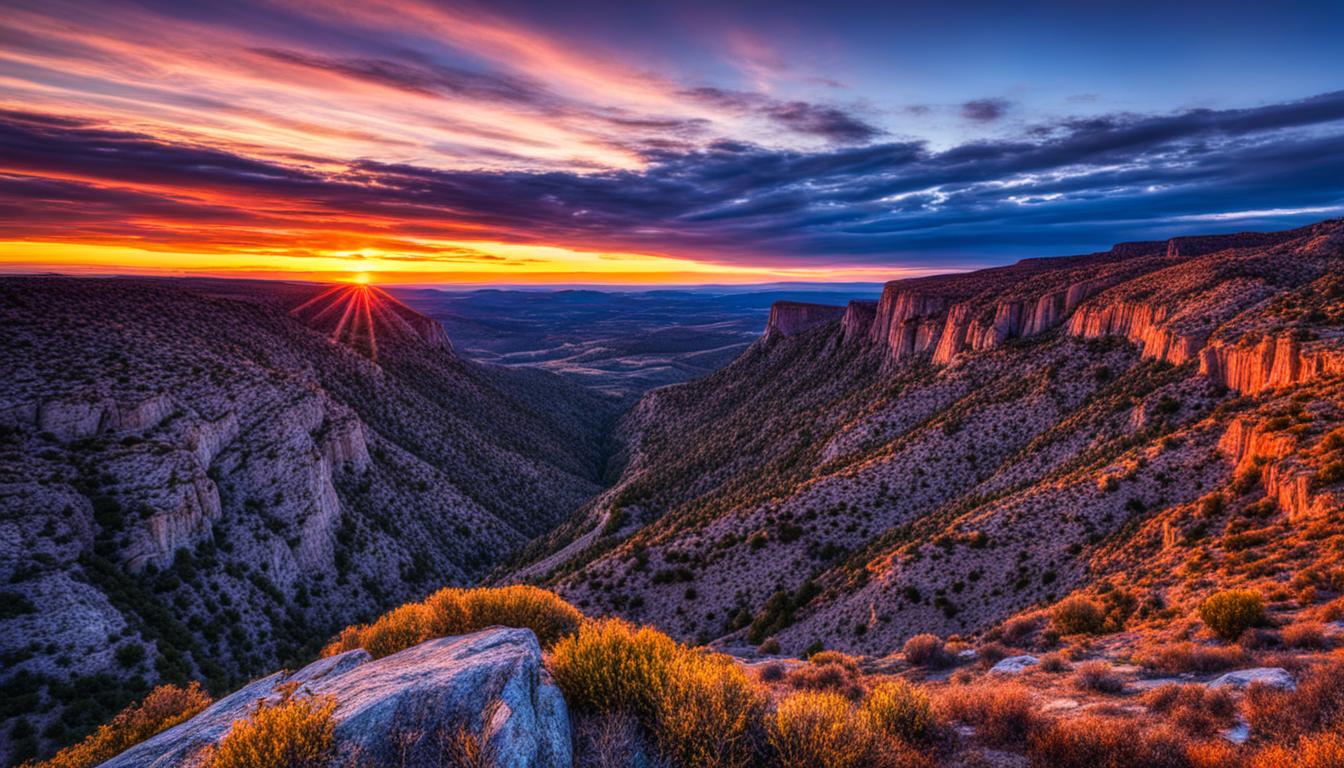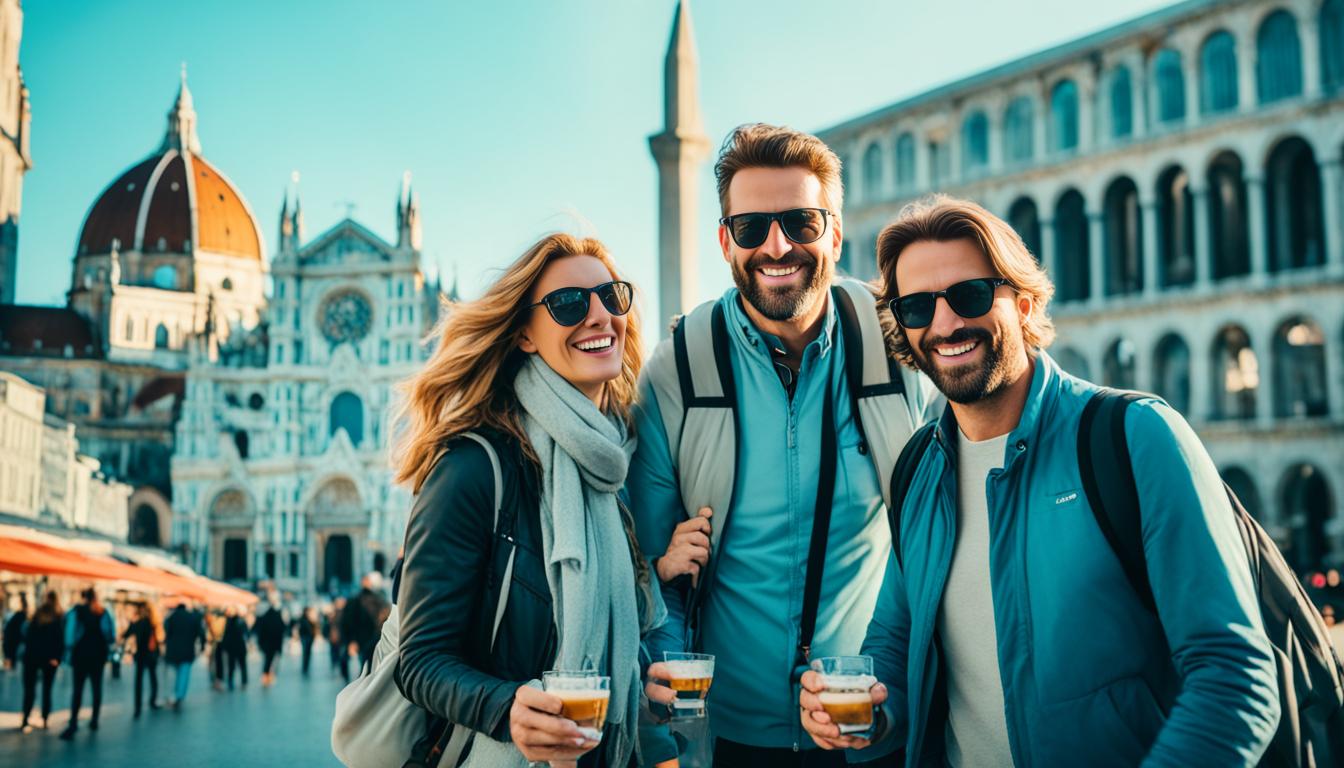When it comes to travel photography, it’s not just about capturing beautiful images; it’s about building a narrative and telling stories through our pictures. Whether we’re exploring exotic destinations, immersing ourselves in local cultures, or capturing candid moments, every photograph has the power to convey a compelling story. In this article, we will explore various techniques and strategies to enhance our storytelling skills through travel photography. From seeking the story behind the scene to using composition techniques, from capturing emotions and moments to playing with light and shadow, we will delve into the art of crafting narratives with our travel photography.
Key Takeaways:
- Storytelling through travel photography involves creating a narrative with our images to engage viewers.
- Seek the story behind the scene by engaging with locals, understanding the history, and observing the environment.
- Capture emotions and moments to add life and depth to your photographs.
- Use composition techniques like leading lines and framing to guide the viewer’s eye and enhance the storytelling aspect.
- Play with light and shadow to set the desired mood and enrich the narrative of your travel photos.
“Seeking the Story Behind the Scene”
To craft a narrative through your travel photography, it’s important to seek the story behind the scene. Engage with locals, learn about the history of a place, and observe the environment to discover unique stories worth capturing. By understanding the context and immersing yourself in the local culture, you can create images that tell a compelling tale.
When we embark on a journey, we are not simply tourists passing through. We become storytellers, curious explorers seeking to capture the essence of a place. To truly understand the soul of a destination, we must engage with locals, listen to their stories, and learn about their traditions. It is through these personal connections that we uncover the hidden narratives waiting to be told.
“Every photograph is a story waiting to be heard, a frozen moment that speaks volumes.”
Delve into the history of a place to gain a deeper appreciation of its significance. Visit historical landmarks, museums, and cultural sites to understand the stories that have shaped the destination. By understanding the historical context, you can infuse your photographs with a sense of time and a connection to the past.
Observing the Environment
Awareness of your surroundings is key to capturing the essence of a place. Observe the environment, paying attention to the details that make it unique. Notice the interplay of light and shadow, the colors that define a landscape, and the textures that evoke a particular mood. These observations will guide you in creating images that transport viewers to the heart of the scene.
When we seek the story behind the scene, we become more than spectators. We become participants in the narrative, capturing moments that reflect the vibrancy of life. Take the time to observe the interactions between people, the laughter shared, and the emotions expressed. These candid shots breathe life into your photographs, eliciting a sense of connection and empathy from your audience.
Join me on a journey through my own photography narrative, where seeking the story, engaging with locals, understanding history, and observing the environment have allowed me to create images that transport viewers to far-off lands, inviting them to be a part of the story.
“Capturing Emotions and Moments”
In travel photography, capturing emotions and moments is essential for creating a compelling storytelling experience. By immortalizing candid shots and tender moments, you breathe life into your photographs, allowing viewers to connect with the authenticity of the scene.
When photographing people, focus on capturing genuine emotions. Seek out candid shots of laughter, joy, or contemplation. These moments reveal the essence of the person and add depth to your images. Whether it’s a child’s genuine curiosity or an elder’s wisdom-filled gaze, these emotional connections create a powerful visual narrative.
Tender moments between couples or loved ones also have the ability to evoke strong emotions. Whether it’s an intimate embrace, a stolen glance, or a shared smile, these moments beautifully capture the essence of human connection and can tell a story of love, friendship, or companionship.
“Photography is a way of feeling, of touching, of loving. What you have caught on film is captured forever. It remembers little things, long after you have forgotten everything.” – Aaron Siskind
Furthermore, candid shots of vendors at bustling markets or street performers showcasing their talent can add an element of liveliness to your photographs. By freezing these fleeting moments, you preserve the energy and vibrancy of a place, enhancing the overall storytelling experience.
To truly bring your photographs to life, embrace the art of capturing emotions and moments. Be present in the moment, observe the world around you, and let your camera be a witness to these genuine connections. As you do, you’ll create images that resonate with viewers and leave a lasting impression.

Key Takeaways:
- Focus on capturing genuine emotions and candid shots to add life and depth to your photographs.
- Tender moments between couples or loved ones evoke strong emotions and tell stories of connection and relationships.
- Incorporate lively scenes, such as market vendors or street performers, to enhance the overall storytelling experience.
- Be present, observe, and let your camera be a witness to these genuine connections.
“Using Composition Techniques to Narrate”
Composition techniques are essential in travel photography as they allow us to effectively communicate narratives through our images. By employing these techniques, such as leading lines, framing, and perspective, we can guide the viewer’s eye and add layers of meaning to our storytelling.
Leading lines are powerful tools that create a visual pathway within an image, directing the viewer’s gaze towards a particular subject or focal point. These lines could be natural elements like roads or rivers, architectural features, or even human-made objects. By strategically incorporating leading lines into our composition, we can draw attention to significant elements within the frame, thereby enhancing the narrative of the photo.
Another technique, framing, involves using elements within the scene to create a frame around the subject. This adds depth and context, allowing the viewer to perceive the subject within its environment. It can be as simple as using natural elements like trees or windows, or more creative, like doorways or arches.
Perspective is another crucial composition technique that can help produce engaging storytelling images. By choosing different vantage points or camera angles, we can offer an alternative view of the subject, stimulating the viewer’s imagination and adding layers of visual interest to the story we are telling.
Adding layers to the story through composition techniques is like adding depth to our narrative. By carefully considering leading lines, framing, and perspective, we can create visually captivating photographs that invite the viewer to explore and discover the story within.
Summary of Composition Techniques
| Composition Technique | Description |
|---|---|
| Leading Lines | Incorporate lines within the frame to guide the viewer’s eye towards the subject or focal point. |
| Framing | Use elements within the scene as a frame to add depth and context to the subject. |
| Perspective | Experiment with different camera angles and vantage points to offer unique viewpoints and enhance the visual narrative. |
“Playing with Light and Shadow”
When it comes to crafting a captivating narrative through travel photography, the interplay of light and shadow can make all the difference. By skillfully manipulating these elements, you can set the mood, add drama and mystery, and enrich the narrative of your images.
Experimenting with different lighting conditions allows you to create a desired atmosphere that enhances the story you want to tell. Whether it’s the soft glow of a sunrise casting a warm hue over a landscape or the dramatic contrast of shadows in a dimly lit alleyway, light can evoke strong emotions and bring your photographs to life.
Shadows, on the other hand, can add depth and intrigue to your travel photos. By strategically incorporating shadows into your composition, you can create an air of mystery, leaving viewers curious and engaged. Shadows can obscure certain elements, leaving room for interpretation and encouraging viewers to fill in the gaps with their imagination.
Take advantage of the dramatic effects that light and shadow can produce. A silhouette against a colorful sunset sky can evoke a sense of romance. Filtering light through architectural structures can create interesting patterns and textures. The juxtaposition of light and shadow can highlight the details that matter most, drawing attention to key elements in your frame.
“Light and shadow are the yin and yang of photography; they work together to enable us to play with mood, add intrigue, and ultimately tell a compelling story.”
Remember, just as in any good story, it’s all about balance. Play with light and shadow to create a visual narrative that captivates your audience and leaves them wanting more.
Making the Most of Light:
- Experiment with different types of natural light, such as golden hour, diffused light, or backlighting.
- Consider the direction and angle of light to create interesting shadows and highlights.
- Use reflectors or bounce light to fill in shadows and bring out details.
- Embrace the dramatic effects of harsh light, like striking patterns or intense shadows.
Harnessing the Power of Shadows:
- Utilize silhouettes to create a sense of mystery and intrigue.
- Seek out strong, defined shadows for a dynamic composition.
- Play with the placement of shadows to direct the viewer’s attention.
- Emphasize textures and shapes through the interplay of light and shadow.
“Creating a Series of Photos”
Sometimes, a single image is not enough to fully capture a story. To provide a more comprehensive view and tell a complete story, creating a series of photos is essential. Each photograph in the series adds a layer of depth and reveals different aspects of the narrative, allowing for a more immersive storytelling experience.
By curating a carefully sequenced series of photos, you can engage viewers and take them on a visual journey. Through a series, you have the opportunity to capture the diverse moments, emotions, and details that contribute to the overall story.
A well-executed series of photos provides a comprehensive view of the subject matter and conveys a more impactful narrative. It allows viewers to connect the dots and understand the story in its entirety. Additionally, a series of photos enables you to explore different perspectives and angles, showcasing diverse perspectives and adding depth to the storytelling process.
When creating a series of photos, consider the flow and progression of the story. Each image should seamlessly connect to the next, creating a cohesive visual narrative. Pay attention to the order in which the photos are presented, as it can significantly impact the viewer’s understanding and engagement with the story.
Through a series of photos, we have the power to tell a complete story, capturing its essence and intricacies. Each photograph adds a layer of meaning, contributing to a comprehensive view that would otherwise be impossible to convey with a single image.
By leveraging the unique qualities and perspectives of each photograph, a series can provide a more in-depth exploration of the subject matter, allowing viewers to immerse themselves fully in the story you want to tell.
To illustrate the concept of creating a series of photos, take a look at the image below:

This visually captivating collection showcases the power of combining multiple images to communicate a comprehensive narrative. Each frame highlights different aspects of the story and contributes to the overall visual storytelling experience.
Creating a series of photos is an effective way to engage your audience and leave a lasting impact. Through a well-curated sequence, you can provide viewers with a comprehensive view that tells a complete story, leaving them captivated and wanting to explore further.
“Including Contextual Elements”
Contextual elements are essential in the art of storytelling through travel photography. By incorporating landscapes, cityscapes, and cultural artifacts into your images, you can provide a rich backdrop that enhances the overall story and captivates viewers. These elements not only add depth and interest to your photographs but also help immerse your audience in the narrative of your journey.
When you include contextual elements such as breathtaking landscapes, vibrant cityscapes, or unique cultural artifacts in your travel photos, you offer viewers a sense of place. Whether it’s a serene beach against a colorful sunset or an ancient temple nestled amidst lush greenery, these elements convey the ambiance and character of your destination, allowing viewers to experience the location vicariously through your lens.
“Capturing the essence of a place goes beyond showcasing its people and landmarks. It’s about capturing the spirit of the environment and the cultural nuances that make it truly special.”
Contextual elements also contribute to the storyline of your travel narrative. They reflect the local culture, history, and identity, giving viewers a deeper understanding of the world you’re exploring. Through these elements, you have the opportunity to showcase the uniqueness of each destination and highlight the connections between people, their surroundings, and their heritage.
Landscapes: A Window Into Nature’s Beauty
By featuring landscapes in your travel photography, you invite viewers to immerse themselves in the natural wonders of the world. Be it vast mountain ranges, serene lakes, or breathtaking waterfalls, landscapes provide a visual feast that showcases the awe-inspiring magnificence of the Earth. These images, captured with a keen eye for composition and light, can transport your viewers to the very heart of your travel experience.
Cityscapes: The Soul of Urban Life
Capturing the essence of a bustling cityscape can be a gateway to a vibrant cultural experience. Showcasing the urban landscapes, iconic buildings, and bustling streetscapes, your images offer a glimpse into the rhythm and energy of city life. Whether it’s the towering skyscrapers of New York City or the colorful markets of Marrakech, cityscapes provide a visual narrative that portrays the vibrancy and diversity of urban cultures across the globe.
Cultural Artifacts: Unveiling the Past
Incorporating cultural artifacts into your travel photos helps create a connection between the present and the past. Ancient ruins, traditional handicrafts, and historical monuments speak volumes about the heritage and legacy of a place. These artifacts are not mere objects; they are windows into history, offering insights into the customs, beliefs, and traditions of the people who came before us. By capturing these artifacts, you preserve their stories and contribute to the collective memory that forms the foundation of any society.
When it comes to travel photography, contextual elements are a powerful tool for enriching the story you want to tell. By carefully selecting and including landscapes, cityscapes, and cultural artifacts, you can transport viewers to the heart of your travel experience and invite them to share in the adventure.
“Conclusion”
Storytelling through travel photography is an art that allows us to capture and share our unique experiences with the world. By implementing the techniques discussed in this article, we can build a compelling narrative in our travel photos. Each aspect, from engaging with locals to capturing emotions and playing with light and shadow, contributes to the visual storytelling process.
Building a narrative in travel photography involves not only taking beautiful images but also conveying a story that resonates with viewers. By creating a series of photos that provide a comprehensive view and including contextual elements like landscapes and cultural artifacts, we can enhance the overall narrative and transport viewers to the heart of our journey.
As we embrace the role of storytellers, it is crucial to pay attention to subtle details and utilize composition techniques to guide the viewer’s eyes through our photographs. By integrating these elements, we can craft exceptional travel photography narratives that captivate and inspire others.
FAQ
What is travel photography narrative?
Travel photography narrative involves telling a story through your pictures, going beyond capturing beautiful images. It aims to engage viewers by building a strong narrative in your travel photos.
How can I create a compelling narrative in my travel photos?
To create a compelling narrative in your travel photos, you can seek the story behind the scene, capture emotions and moments, use composition techniques, play with light and shadow, create a series of photos, include contextual elements, and pay attention to subtle details.
How can I seek the story behind the scene in travel photography?
By engaging with locals, learning about the history of a place, and observing the environment, you can discover unique stories worth capturing in your travel photos.
How can I capture emotions and moments in travel photography?
Candid shots of people laughing, tender moments between couples, or vendors at markets can add life and depth to your photographs, evoking emotions and connecting with viewers on a deeper level.
What composition techniques can I use to narrate a story in travel photography?
Techniques such as leading lines, framing, and perspective can guide the viewer’s eye and add layers to your narrative, enhancing the storytelling aspect of your travel photos.
How can light and shadow impact the narrative in travel photography?
By playing with different lighting conditions, you can set the desired mood and atmosphere for your storytelling. Shadows can add drama and mystery, enriching the narrative of your travel photos.
Why should I create a series of photos in travel photography?
Sometimes, a single image is not enough to fully capture a story. By creating a series of photos, you can provide a more comprehensive view and tell a complete story, engaging viewers and offering a more immersive storytelling experience.
How can I include contextual elements in my travel photos?
Incorporating landscapes, cityscapes, or cultural artifacts into your images can provide context to your subject and enhance the overall story, helping viewers understand the setting and immerse themselves in the narrative of your photographs.
Why is storytelling important in travel photography?
Storytelling through travel photography is a powerful way to capture and share your experiences. By following the techniques mentioned above, you can build a strong narrative in your travel photos and let your images narrate the tales of your journey.
Can Travel Photography Narrative Techniques be Applied to Crafting Stories Through Images?
Travel photography narrative techniques can indeed be applied to crafting stories through images. By incorporating elements such as composition, lighting, and perspective, photographers can effectively convey a compelling and immersive narrative through their images, allowing viewers to experience the story being told within each frame.




